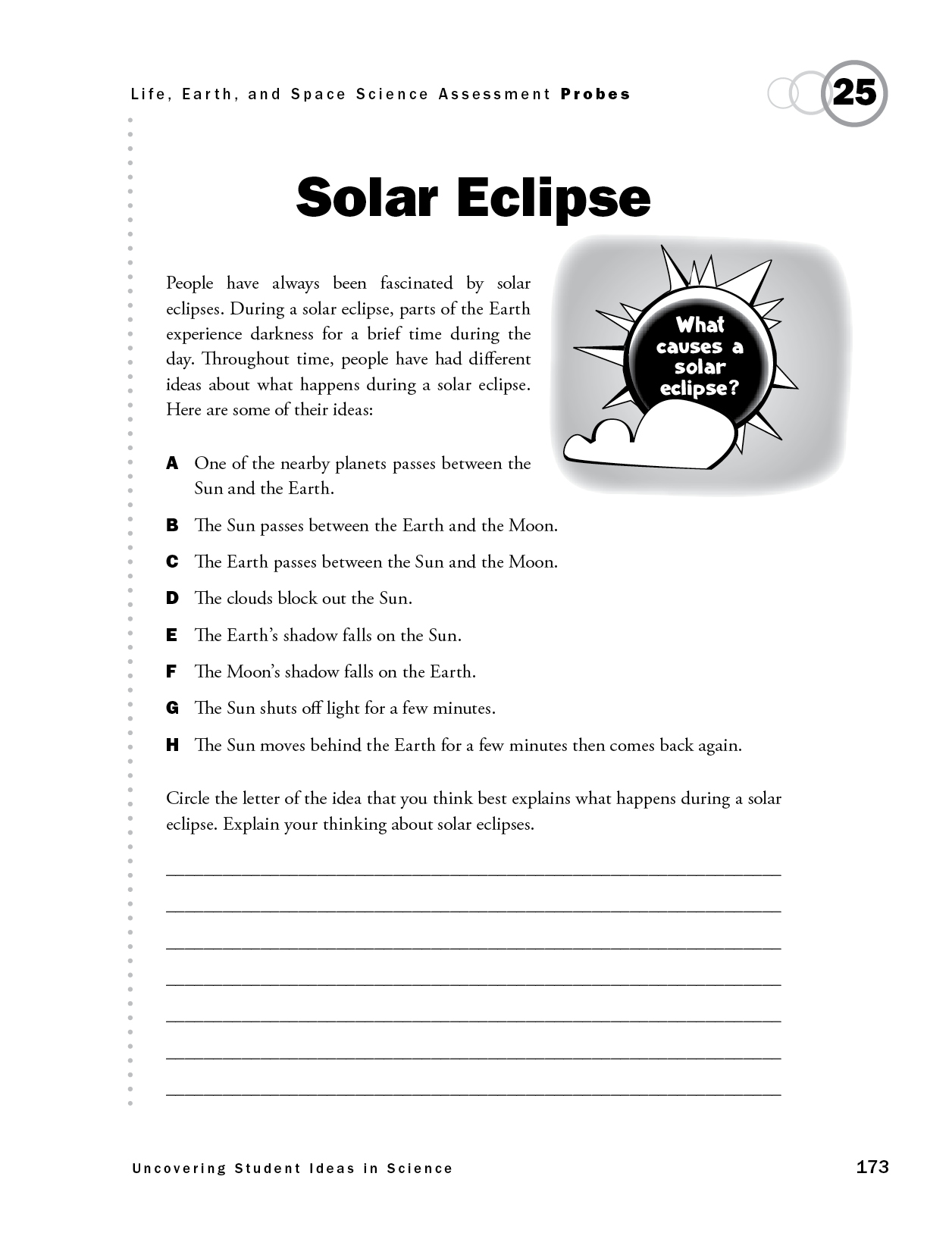Middle School | Formative Assessment Probe
Solar Eclipse
By Page Keeley
Assessment Earth & Space Science Middle School
Sensemaking Checklist




This is the new updated edition of the first book in the bestselling Uncovering Student Ideas in Science series. Like the first edition of volume 1, this book helps pinpoint what your students know (or think they know) so you can monitor their learning and adjust your teaching accordingly. Loaded with classroom-friendly features you can use immediately, the book includes 25 “probes”—brief, easily administered formative assessments designed to understand your students’ thinking about 60 core science concepts.

Purpose
The purpose of this assessment probe is to elicit students’ ideas about eclipses. The probe is designed to find out what students think happens during a solar eclipse.
Type of Probe
Sequencing
Related Concepts
solar eclipse
Explanation
The best answer is F: The Moon’s shadow falls on the Earth. A solar eclipse occurs during a new Moon when the Moon is directly aligned with the Earth and the Sun. A bright halo of the Sun’s light (the solar corona) surrounding the disk of the Moon can be seen with the naked or unaided eye. Only during this brief time— when the Moon covers the Sun completely (for four to six minutes)—can the Sun be viewed without special eye protection. Leading up to and after these brief moments of totality, special protective eclipse glasses must be worn or the Sun should be viewed through projection.
Because the Moon is blocking the light from the Sun, it causes a shadow to fall on the Earth, which results in the eerie change from daylight to darkness. To see a total eclipse, one must be in the path of totality. This path can be up to 200 miles wide and is the path that the Moon’s shadow makes on the Earth during the eclipse. Observers within a certain distance away from totality can see a partial eclipse, in which the Moon does not completely obscure the Sun.
Curricular and Instructional Considerations
Elementary Students
In the elementary grades, students learn basic ideas about the Moon and the Sun. Explanations for Earth, Moon, and Sun phenomena such as phases of the Moon and lunar and solar eclipses should be observational, not explanatory, at this age.
Middle School Students
In the middle grades, students develop a more sophisticated understanding of the Earth- Moon-Sun system, including explanations for the phases of the Moon and eclipses. At this grade level, they should be able to compare and contrast the difference between a lunar and solar eclipse and be able to state what causes a solar eclipse. The use of models at this grade level is very important for developing an understanding of Earth-Moon-Sun phenomena.
High School Students
Students at the high school level develop a more sophisticated understanding of eclipses by using their increased understanding of spatial geometry and understanding of light and shadows. Students can also use databases to look for patterns and to predict when and where an eclipse will occur. However, students at this level may still harbor commonly held misconceptions about eclipses.
Administering the Probe
Ask students if they or anyone they know has ever experienced a solar eclipse. Consider showing a photograph of a solar eclipse from the internet or other source when using this probe, being careful not to clue the students as to the cause of the eclipse.
Related Research
- Students’ understanding of eclipse phenomena may be related to their lack of understanding of the relative sizes and distances apart of the Sun, Earth, and Moon. Many students draw these objects so they are the same size or between half and double each other’s size. They also draw the Sun and Moon within one to four Earth diameters away from the Earth (Driver et al. 1994).
- Astronomical phenomena are very challenging for students. To understand these phenomena, students must first understand the motion and position in the Earth- Moon-Sun system (AAAS 1993).
Related NSTA Resources
Gilbert, S., and S. Ireton. 2003. Understanding models in earth and space science. Arlington, VA: NSTA Press.
National Science Teachers Association (NSTA). 2008. Earth, Sun, and Moon. NSTA SciPack. Online at http://learningcenter.nsta.org/product_ detail.aspx?id=10.2505/6/SCP-ESM.0.1
Riddle, B. 2005. Science scope on the skies: You’re blocking the light. Science Scope (Oct.): 70–72.
Riddle, B. 2007. Scope on the skies: Total lunar eclipse. Science Scope (Mar.): 76–78.
Suggestions for Instruction and Assessment
- A solar eclipse is a phenomenon that is best explained and understood using physical models. However, having students merely observe a model demonstrated by the teacher is less effective in building understanding than having students manipulate their own models. It is important that students have opportunities to make and use their own models to understand eclipse phenomena.
- Have students use their models to compare and contrast a lunar and a solar eclipse.
- Google NASA websites to find data on and activities related to solar eclipses. There are many websites developed for education that target eclipse ideas.
- The PRISMS (Phenomena and Representations for Instruction of Science in Middle Schools) website, an NSDL (National Science Digital Library) resource, maintains a collection of reviewed lunar and solar eclipse phenomena and representations teachers can use for instructional purposes. To access this collection, go to http://prisms. mmsa.org.


